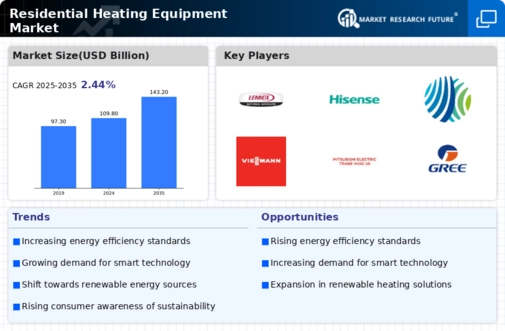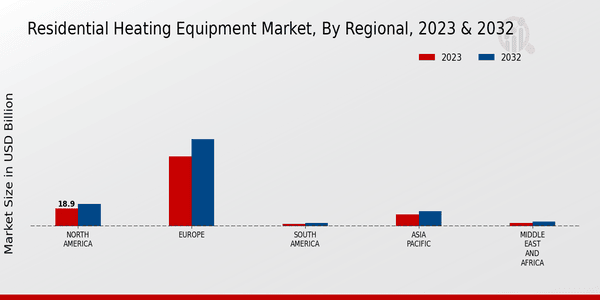Rising Disposable Income
An increase in disposable income across various regions contributes positively to the Global Residential Heating Equipment Market Industry. As households experience improved financial conditions, they are more inclined to invest in advanced heating solutions that offer enhanced comfort and efficiency. This trend is particularly evident in emerging economies, where urbanization and economic growth are driving demand for modern residential heating systems. The willingness to spend on quality heating equipment is likely to bolster market growth, with projections indicating a market value of 143.2 USD Billion by 2035. This correlation between income levels and heating equipment purchases underscores the importance of economic factors in market dynamics.
Market Growth Projections
The Global Residential Heating Equipment Market Industry is projected to experience steady growth over the coming years. With a market value of 109.8 USD Billion in 2024, it is anticipated to reach 143.2 USD Billion by 2035. This growth trajectory suggests a compound annual growth rate (CAGR) of 2.44% from 2025 to 2035. Factors contributing to this expansion include technological advancements, increasing demand for energy efficiency, and supportive government policies. As the market evolves, it is likely to witness the introduction of innovative products and solutions that cater to changing consumer preferences and environmental considerations.
Technological Advancements
Technological innovations play a pivotal role in shaping the Global Residential Heating Equipment Market Industry. The integration of smart technologies, such as IoT-enabled thermostats and automated heating systems, enhances user experience and operational efficiency. These advancements allow homeowners to monitor and control their heating systems remotely, optimizing energy use. As the market evolves, manufacturers are increasingly investing in research and development to create more sophisticated heating solutions. This trend is likely to contribute to market growth, with projections indicating a market value of 143.2 USD Billion by 2035. The continuous evolution of technology suggests a competitive landscape that prioritizes innovation.
Government Regulations and Incentives
Government policies and incentives significantly influence the Global Residential Heating Equipment Market Industry. Many countries are enacting stringent regulations aimed at reducing greenhouse gas emissions and promoting renewable energy sources. Incentives for homeowners to upgrade to more efficient heating systems are becoming commonplace, encouraging investments in modern technologies. For instance, tax credits and rebates for energy-efficient appliances are prevalent in various regions. These initiatives not only stimulate market growth but also align with global sustainability efforts. As a result, the market is expected to grow at a CAGR of 2.44% from 2025 to 2035, reflecting the impact of regulatory frameworks on consumer behavior.
Growing Awareness of Indoor Air Quality
The Global Residential Heating Equipment Market Industry is increasingly influenced by the growing awareness of indoor air quality among consumers. With a heightened focus on health and well-being, homeowners are seeking heating solutions that not only provide warmth but also improve air quality. Advanced heating systems equipped with air filtration and purification technologies are gaining popularity. This trend is expected to drive demand for residential heating equipment that addresses both comfort and health concerns. As consumers prioritize indoor air quality, manufacturers are likely to respond with innovative products, further shaping the market landscape in the coming years.
Increasing Demand for Energy Efficiency
The Global Residential Heating Equipment Market Industry experiences a rising demand for energy-efficient heating solutions. As consumers become more environmentally conscious, they seek systems that reduce energy consumption and lower utility bills. Energy-efficient technologies, such as condensing boilers and heat pumps, are gaining traction. In 2024, the market is valued at approximately 109.8 USD Billion, reflecting a shift towards sustainable practices. Governments worldwide are implementing regulations and incentives to promote energy efficiency, further driving this trend. The emphasis on reducing carbon footprints aligns with global sustainability goals, indicating a robust future for energy-efficient heating equipment.











